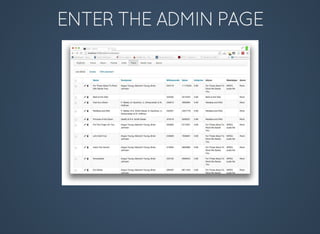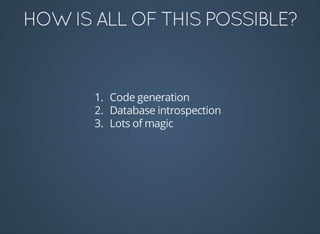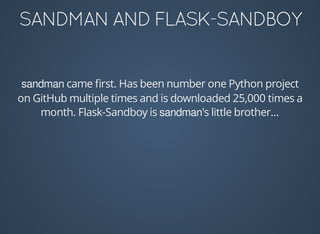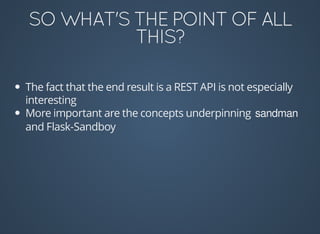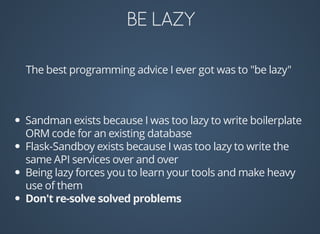Building Automated REST APIs with Python
- 28. A REST API allows to send to manipulate . ...So we need to write a server capable of accepting HTTP requests, acting on them, and returning HTTP responses.
- 67. Would be nice to be able to visualize your data in addition to interacting with it via REST API.
- 69. 1. Code generation 2. Database introspection 3. Lots of magic



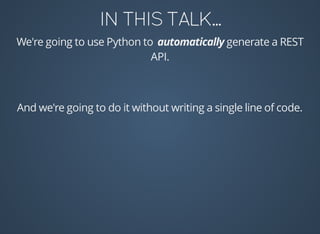





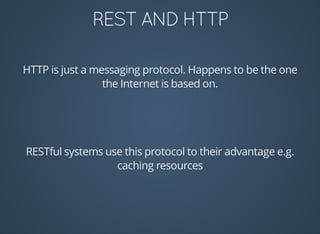




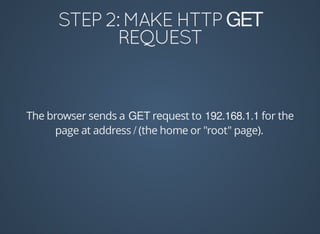















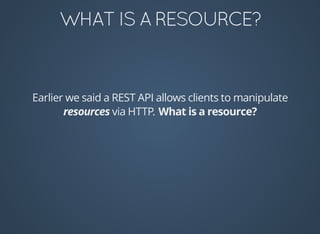




![All resources must be identified by a unique address at which
they can be reached, their URI. This requires each resource
contain a unique ID, usually a monotonically increasing
integer or UUID (like a primary key in a database table).
Our pattern for building URLs will be
/resource_name[/resource_id[/resource_attribute]]](https://image.slidesharecdn.com/automated-rest-apis-in-python-140716163719-phpapp01/85/Building-Automated-REST-APIs-with-Python-35-320.jpg)

![class SerializableModel(object):
"""A SQLAlchemy model mixin class that can serialize itself as JSON."""
def to_dict(self):
"""Return dict representation of class by iterating over database
columns."""
value = {}
for column in self.__table__.columns:
attribute = getattr(self, column.name)
if isinstance(attribute, datetime.datetime):
attribute = str(attribute)
value[column.name] = attribute
return value](https://image.slidesharecdn.com/automated-rest-apis-in-python-140716163719-phpapp01/85/Building-Automated-REST-APIs-with-Python-37-320.jpg)
![Here's the code that handles retrieving a single tweet and
returning it as JSON:
from models import Tweet, User
@app.route('/tweets/<int:tweet_id>', methods=['GET'])
def get_tweet(tweet_id):
tweet = Tweet.query.get(tweet_id)
if tweet is None:
response = jsonify({'result': 'error'})
response.status_code = 404
return response
else:
return jsonify({'tweet': tweet.to_dict()})](https://image.slidesharecdn.com/automated-rest-apis-in-python-140716163719-phpapp01/85/Building-Automated-REST-APIs-with-Python-38-320.jpg)

![@app.route('/tweets/', methods=['POST'])
def create_tweet():
"""Create a new tweet object based on the JSON data sent
in the request."""
if not all(('content', 'posted_at', 'user_id' in request.json)):
response = jsonify({'result': 'ERROR'})
response.status_code = 400 # HTTP 400: BAD REQUEST
return response
else:
tweet = Tweet(
content=request.json['content'],
posted_at=datetime.datetime.strptime(
request.json['posted_at'], '%Y-%m-%d %H:%M:%S'),
user_id=request.json['user_id'])
db.session.add(tweet)
db.session.commit()
return jsonify(tweet.to_dict())](https://image.slidesharecdn.com/automated-rest-apis-in-python-140716163719-phpapp01/85/Building-Automated-REST-APIs-with-Python-40-320.jpg)

![@app.route('/tweets', methods=['GET'])
def get_tweet_collection():
"""Return all tweets as JSON."""
all_tweets = []
for tweet in Tweet.query.all():
all_tweets.append({
'content': tweet.content,
'posted_at': tweet.posted_at,
'posted_by': tweet.user.username})](https://image.slidesharecdn.com/automated-rest-apis-in-python-140716163719-phpapp01/85/Building-Automated-REST-APIs-with-Python-42-320.jpg)




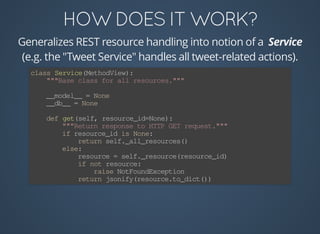
![def _all_resources(self):
"""Return all resources of this type as a JSON list."""
if not 'page' in request.args:
resources = self.__db__.session.query(self.__model__).all()
else:
resources = self.__model__.query.paginate(
int(request.args['page'])).items
return jsonify(
{'resources': [resource.to_dict() for resource in resources]})](https://image.slidesharecdn.com/automated-rest-apis-in-python-140716163719-phpapp01/85/Building-Automated-REST-APIs-with-Python-48-320.jpg)


!['GET','PUT','DELETE','PATCH','OPTIONS'])
TYPE
In Python, type with one argument returns a variable's type.
With three arguments,
.](https://image.slidesharecdn.com/automated-rest-apis-in-python-140716163719-phpapp01/85/Building-Automated-REST-APIs-with-Python-51-320.jpg)
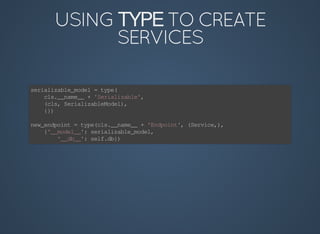
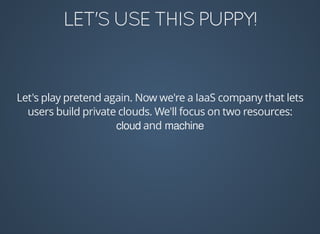

![from flask import Flask
from flask.ext.sandboy import Sandboy
from models import Machine, Cloud, db
app = Flask(__name__)
app.config['SQLALCHEMY_DATABASE_URI'] = 'sqlite:///db.sqlite3'
db.init_app(app)
with app.app_context():
db.create_all()
sandboy = Sandboy(app, db, [Machine, Cloud])
app.run(debug=True)](https://image.slidesharecdn.com/automated-rest-apis-in-python-140716163719-phpapp01/85/Building-Automated-REST-APIs-with-Python-55-320.jpg)



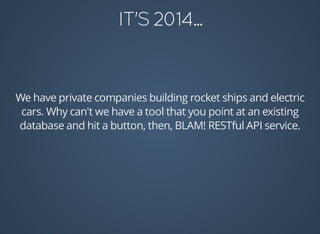
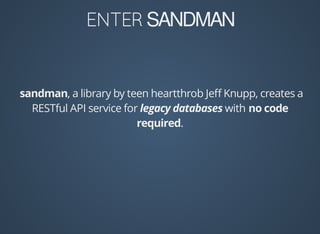

![$ curl -v localhost:8080/artists?Name=AC/DC
HTTP/1.0 200 OK
Content-Type: application/json
Date: Sun, 06 Jul 2014 15:55:21 GMT
ETag: "cea5dfbb05362bd56c14d0701cedb5a7"
Link: </artists/1>; rel="self"
{
"ArtistId": 1,
"Name": "AC/DC",
"links": [
{
"rel": "self",
"uri": "/artists/1"
}
],
"self": "/artists/1"
}](https://image.slidesharecdn.com/automated-rest-apis-in-python-140716163719-phpapp01/85/Building-Automated-REST-APIs-with-Python-62-320.jpg)





